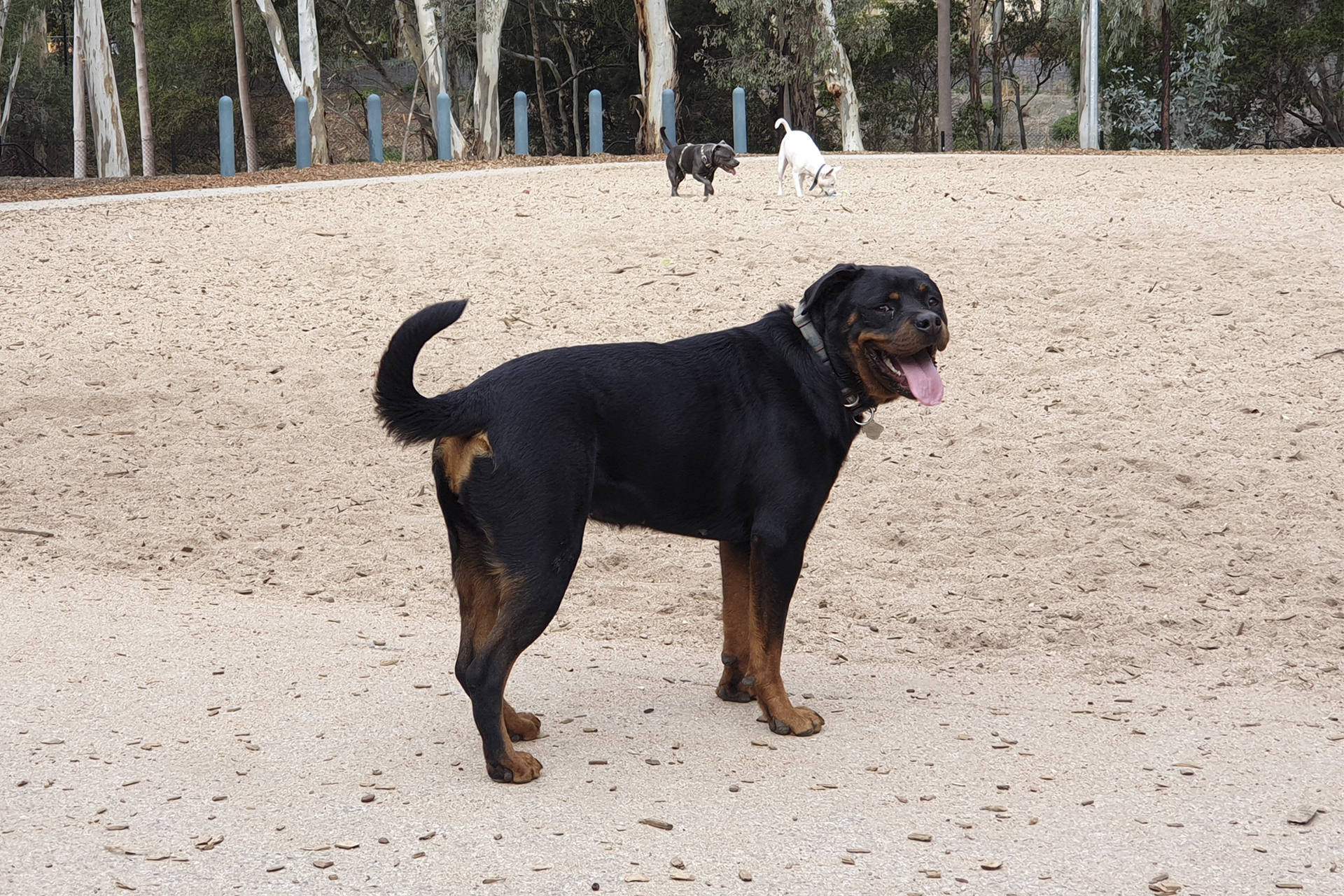
Dog parks are a great place for social dogs to explore, make new friends, exercise and socialise! As a pet parent, watching your dog zoom around the space with an enthusiasm that rivals the strength of the sun is such a wonderful experience.
It is common sense that dog parks are for friendly, sociable, confident dogs to enjoy some off lead time with other, like-minded friends. However, dog parks are not suitable for all dogs such as those which are unwell or in heat, dogs that are very old (and perhaps arthritic or going blind), recovering from injuries, under 6 months (where they are still building confidence and a potential negative experience can have lasting consequences for their socialisation in the future), or dogs that are shy, nervous or timid. Dog parks are also not the place to test if your dog likes other dogs, to attempt to build their confidence by throwing them in the ‘deep end’, or to rely on another dog to tell them off for being rude or playing inappropriately. Every dog in the park deserves to enjoy their experience there, feeling safe, happy and comfortable with every interaction.
Somehow, in our community, there is a pervasive thought that all our dogs must enjoy play with other dogs to live their best lives, and/ or that we must ensure our dogs play with other dogs in order to be good pet parents. In actual fact, neither of these is true or necessary. Just like us, so many dogs prefer the company of a few good friends or prefer peace and quiet. At the risk of anthropomorphising, dogs can be introverts too. Lots of dogs love catching up with dogs they know well, but don’t appreciate being placed in a confined space with a bunch of unfamiliar, enthusiastic and well intentioned (but potentially pushy and rude) playmates.
Long sniffy walks, off lead adventures in safe reserves (if the dog is under effective control), training based on positive reinforcement, snuggling on the couch and playing tug or throwing the ball are all ways your dog can enjoy each and every day to the fullest! Of which, playing in a dog park might only be one small aspect for some dogs.
If you do go to dog parks, here are some top tips on proper dog park use to summarise the messages we shared during Doggy Festival Dog park etiquette sessions in 2021.
1) Keep play short (10-15min)
As with children, dog play can spiral out of control pretty quickly and they can get ratty and over-tired. Being in the dog park for more than 15 minutes can actually have an adverse effect on your dog’s play style and behaviour (depending on who else is in there with you) – things can become increasingly intense until someone makes a poor choice and pushes someone too far. Instead of an outing to the dog park for half an hour, consider incorporating a dog park visit into your walk for 10-15minutes with lots of chances to sniff on lead before and after. Or, perhaps you could intersperse 10min dog park plays with a short sniffy walk outside the park to help give them a chance to calm down properly before going back in.
2) Play should have lots of natural breaks and pauses
What’s more - appropriate, safe and happy play should contain lots of very brief pauses where dogs freeze for a second, or have a short sniff, or peel away from each other before coming back for more. They allow dogs to process what happened and should be occurring frequently in play (hopefully every minute or so). Sometimes these breaks involve a shake off (where they shake as if they have a wet coat). This is a tension reliever and lets us know the dog is trying to calm down after a particularly intense type of play. Sometimes the pause leads to a longer break in play where both dogs go their separate ways for a really good sniff or to check back in with their parents. This is lovely information both dogs recognised the play was becoming too much and they needed a break to calm down. It is unnatural for play to occur completely unregulated or uninterrupted for minutes at a time. If this is happening, you may need to step in to help your dog learn to do it themselves (by gently taking their collar and encouraging them to come away and explore a different section of the park).
3) Altercations are not normal
Dog body language has evolved specifically for the purpose of avoiding conflict. It aims to communicate feelings and intentions clearly so play or other interactions don’t get out of control. It is not normal for dogs to fight, and not normal for them to ‘figure it out’ or ‘tell each other off’. If an altercation occurs, something went wrong and we (as the parents supervising that play) weren’t watching closely enough. Dog’s that don’t read each other’s body language need your help to learn. If they’re not responding to what another dog is communicating, they may be too excited to think straight. This will often happen if we have allowed play to carry on for too long or the play has no natural breaks in it.
4) Socialisation is not what you think
When we socialise young dogs, we tend to fall into the trap of over-emphasising play with other dogs, and under-focusing on socialisation with other people, places and things. Socialisation does not equal play. Of course, some (controlled and appropriate) play is incredibly invaluable for dogs as they grow, but it is also equally important for them to learn that they can’t play with every dog. Allowing dogs to play every time they are off lead, or every time they see other dogs, is the quickest way to teach them to ‘go crazy’ (with excitement) every time they see other dogs. Your practice of being calm and relaxed in the presence of other dogs or people should far outweigh any play or interactions they get with dogs and people.
5) Play and needs change as dogs age
Young dogs (under 1 year) might enjoy meeting lots of new and unfamiliar dogs in safe settings where they can build their confidence, learn lots about what appropriate play and interactions look like, and associate you with all those positives and safety too. Of course it depends on the dog, but as they get older you will likely find their play styles will change. Just like us. While most of us enjoyed playing with new kids on playgrounds as children, or perhaps clubbing in our early 20s, we tend to gravitate more to people we know well, trust and can be comfortable and relaxed with as we age. Be sure to adapt your walking and exercise routines as your dog’s needs change as they grow older.
6) Watch your dog closely
Learn how to read your dog’s body language to get a good idea of whether they are enjoying themselves or not. You can learn more about dog body language here. Play should involve two or three dogs actively engaging in play with each other (instead of one dog always chasing others). Play between dogs should involve lots of approaching from the side, or running alongside each other (rather than approaches head on, or pinning or height seeking/boxing behaviours).
But also, watching how they use the dog park space can be incredibly valuable information. Are they hanging around you more, exploring the outer edges, doing lots of sniffing, only focused on a ball, or running at others in their best impersonation of a steam-roller? If your dog is showing a preference for sniffing, walking, chasing the ball, or hanging with you, consider doing those things outside the dog park sometimes too. For the energetic steam-rollers or hock-nipping herders, their attempts at play (albeit well intentioned) are also inappropriate. While some dogs they regularly play with might understand and cope fine, it is crucial that these dogs also learn to tailor their play to suit other dogs too. Often this can be as simple as actively encouraging them to pause and calm down frequently throughout play by keeping play sessions very short to start with.
7) If you’re not sure about the play occurring, get them out of there
You are always your dog’s advocate. If you’re at all unsure about the play that is occurring, call them away (or go and get them if needed) and go for a walk instead. It is always better to be safe than sorry, and prevention of negative experience is always better than re-training undesirable habits or fear responses. There are only so many negative or scary experiences can happen before dogs begin to change the way they interact with others, especially for young dogs going through critical social development periods before 2 years of age. If you’re at all unsure, get them out of there and come back when it’s quieter another day.
8) Aim for a content dog, rather than an exhausted dog
Dog parks can be addictive because after a really good run with other dogs, your dog is tired and tired dogs are easy to live with. But if your dog park run involves uninterrupted, unregulated play for a long period of time where your dog is able to be excited non-stop before coming home exhausted, you’ll find it has two outcomes:
1 - They get fitter and better at ‘going nuts’ each time they get to practice that behaviour – so it will take more and more as they grow to tire them out
2 - Exhaustion isn’t the same as a good dog. Exhaustion doesn’t replace training, and it doesn’t help in situations where you can’t get your dog out (really long work days, when it’s raining and too cold, or the middle of summer, or if your dog becomes injured or unwell and can’t go for walks or play for a while).
Exercise is very important, of course, but don’t be afraid to switch it up. Going for SCENTsational walks in new places, and reinforcing your dog for relaxed and settled behaviour are equally valuable.
